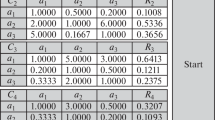Abstract
Information availability is often a critical point for the application of classical quantitative techniques for production system analysis. In several production problems, indeed, managers have considered the possibility to incorporate “expert” estimates of production data into a model as a substitute for hard data as very interesting. Furthermore, the use of qualitative representations to model physical systems is attractive because it allows to capture the inherent ambiguity characterizing real systems. Fuzzy set theory allows to gain such attractive options, since it provides tools to process vague information.
This paper concerns the new and interesting topic of fuzzy discrete event simulation. In particular, the problem of processing fuzzy data within a discrete event simulation process is discussed and new methods, able to limit time paradox problems, are proposed. Furthermore, the paper addresses the comparison among fuzzy and classical simulation, pointing out peculiarities, potentialities and application fields of such a new tool; finally, the research highlights the necessity to develop proper and specific fuzzy simulation packages by demonstrating that, even under specific and simplifying hypotheses about process uncertainties, fuzzy simulation analysis results cannot be obtained through classical simulation packages.
Similar content being viewed by others
References
Alan, A. and Prisker, B. (1974) The Gasp IV Simulation Language, Wiley-Interscience.
Anglani, A., Grieco, A. and Nucci, F. (1998) Representation and use of uncertainty in discrete event simulation models. European Simulation Symposium ESS'98, Nottingham U.K.
Bortolan, G. and Degani, R. (1985) A review of some methods for ranking fuzzy subsets. Fuzzy Sets and Systems, 15, 1-19.
Chen, S. H. (1985) Ranking fuzzy numbers with maximising set and minimising set. Fuzzy Set and Systems, 17, 113-129.
Dohnal, M. (1983) Fuzzy simulation of industrial problems. Computers In Industry, 4, 347-352.
Dubois, D. and Prade, H. (1983) Ranking fuzzy numbers in the setting of possibility theory. Information Sciences, 30, 183-224.
Dubois, D. and Prade, H. (1978) Operations on fuzzy numbers. Int. J. of Systems Science, 9, 613-626
Fichera, S., La Spada, A., Perrone, G., Grasso, V. and La Commare, U. (1999) Possibilistic programming and GAs for aggregate production planning under vague information, recent development in the design and control of cold forming processes, in the Proceedings of AMST 99, edited by Kuljanic, SpringerWien, NewYork, pp. 485-492.
Fishwick, P. A. (1991) Fuzzy simulation: Specifying and identifying qualitative models. Int. J. of General Systems, 19, 295-316.
Fortemps, P. (1997) Job shop scheduling with imprecise duration: A fuzzy approach, IEEE Transactions on Fuzzy Systems, 5, 557-569.
Guiffrida, A. L. and Nagi, R. (1997) Fuzzy set theory application in production management research: A literature survey. Journal of Intelligent Manufacturing, 9, 39-56.
Hong, T.-P. and Chuang, T.-N. (1999) A new triangular fuzzy Johnson algorithm. Computers & Industrial Engineering, 36, 179-200.
Inuiguchi, M., Sakawa, M. and Kume, Y. (1994) The usefulness of possibilistic programming in production planning problems. Int. J. of Prod. Econ., 33, 45-52.
Ishibuchi, H., Murata, T. and Lee, K.-H. (1996) Formulation of fuzzy shop scheduling problems with fuzzy processing times, in the Proc. of the Fifth IEEE Int. Conf. on Fuzzy Systems, 8–11, New Orleans, Louisiana, USA.
Ishii, H., Tada, M. and Masuda, T. (1992) Two scheduling problems with fuzzy due date. Fuzzy Set and Systems, 46, 339-347.
Kelton, W. D., Sadowsky, R. P. and Sadowski, D. A. (1998) Simulation with Arena, McGraw Hill.
Klir, G. J. and Yuan Bo (1995) Fuzzy Sets and Fuzzy Logic: Theory and Applications, Prentice Hall.
Kuroda, M. and Wang, Z. (1996) Fuzzy job shop scheduling. Int. J. of Prod. Econ., 44, 45-51
Law, A. M. and Kelton, W. D. (1991) Simulation Modelling and Analysis, 2nd edn., McGraw-Hill, New York, NY.
Li, R.-J. and Lee, E. S. (1989) Analysis of Fuzzy Queues. Computers Math Applications, 17, 1143-1147.
Negi, D. S. and Lee, E. S. (1992) Analysis and simulation of fuzzy queues. Fuzzy Sets and Systems, 46, 321-330.
Ozelkan, C. O. and Duckstein, L. (1999) Optimal fuzzy counterparts of scheduling rules. European Journal of Operational Research, 113, 593-609
Pegden, C. D., Shannon, R. E. and Sadowski, R. P. (1995) Introduction to Simulation Using SIMAN, 2nd edn, McGraw-Hill, New York, NY.
Perrone, G. and Noto La Diega, S. (1996) Strategic FMS design under uncertainty: A fuzzy set theory based model, Int. J. of Prod. Econ., 46–47, 549-561.
Perrone, G. and Noto La Diega, S. (1998a) Fuzzy methods for analysing fuzzy production environment. Robotics and Computer-Integrated Manufacturing, 14, 465-474.
Perrone, G., Noto La Diega, S. and Zinno, A. (1998b) A fuzzy discrete event simulator for fuzzy production environment analisys. Annals of CIRP 47/1/98, 405-408.
Perrone, G., Noto La Diega, S. and Zinno, A. (1998c) A fuzzy discrete event simulator for fuzzy production system analysis, Proceeding of INCOM' 98, III: 105-110.
Tian-Shy, L., Mao-Jiun, J., Wang (1992) Ranking fuzzy numbers with integral value. Fuzzy Sets and Systems, 50, 247-255.
Tsujimura, Y., Gen, M. and Kubota, E. (1995) Solving fuzzy assembly lines balancing problem with genetic algorithms, Computers & Industrial Engineering, 29, 543-547.
Yufei, Y., (1991) Criteria for evaluating fuzzy ranking methods. Fuzzy Sets and Systems, 44, 139-157.
Zinno A., Perrone G. and Noto La Diega S., (1999) A possibilistic based approach method for fuzzy discrete event simulation. Annals of AITEM '99, Brescia (Italy), September 1999, 405-408.
Author information
Authors and Affiliations
Rights and permissions
About this article
Cite this article
Perrone, G., Zinno, A. & La Diega, N. Fuzzy discrete event simulation: A new tool for rapid analysis of production systems under vague information. Journal of Intelligent Manufacturing 12, 309–326 (2001). https://doi.org/10.1023/A:1011213412547
Issue Date:
DOI: https://doi.org/10.1023/A:1011213412547




